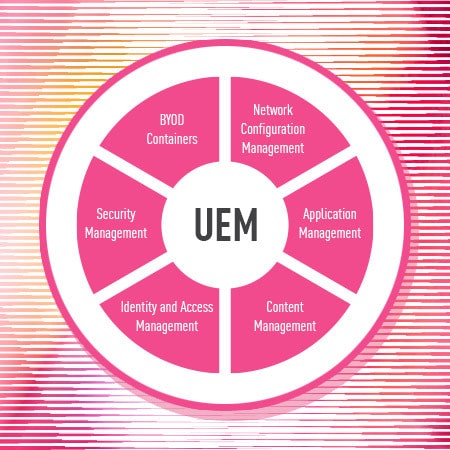What is Unified Endpoint Management (UEM)?
The COVID-19 pandemic drove a massive shift to remote work. After this forced experiment, many organizations are looking to support remote and hybrid work indefinitely.
Companies looking to maintain a remote workforce need to ensure that their remote employees are secure. Remote devices generally are less compliant with corporate security policies and may lack the same defenses that protect on-premises devices. Unified endpoint management (UEM) solutions provide companies with the ability to effectively and scalably monitor and manage their remote endpoints.

What Is Unified Endpoint Management (UEM)?
Mobile Device Management (MDM) solutions allow an organization to centrally monitor and manage the mobile devices used by its remote workforce. However, remote employees do not only use mobile devices when working from outside the office. Home offices also include traditional endpoints (laptops, desktops, etc.) that MDM solutions are not designed to manage.
UEM solutions expand on the role of MDM to include support for an organization’s other endpoints. Instead of simply monitoring and managing mobile devices, UEM solutions offer support for desktops and laptops in home offices. This enables an organization to deploy a single solution for monitoring all of its remote endpoints.
The Benefits Of Unified Endpoint Management
UEM solutions are designed to provide a single solution for companies to monitor and manage their endpoints, including both mobile devices and traditional endpoints. The design of UEM solutions and their ability to replace multiple standalone solutions provides significant benefits to an organization, including:
- Single Pane of Glass Management: Remote and hybrid work make it more difficult for an organization to monitor and manage the devices used by its remote workforce. UEM solutions enable a business to manage both mobile devices and traditional endpoints from a single solution, improving visibility and simplifying management.
- Integrated Security: Poor patch management and non-compliance with corporate security policies are common problems with remote devices. UEM solutions enable an organization to monitor and enforce compliance across its entire workforce, limiting the security gaps that an attacker could exploit in an organization’s endpoints.
- Threat Detection: Endpoints are increasingly a target of cybercriminals and other threat actors as they move outside of the corporate network and its perimeter-based defenses. UEM solutions have deep insight into the endpoints that they monitor, enabling them to detect abnormal behaviors or other indications that an endpoint has been compromised by an attacker. This enables security teams to respond to potential threats before they pose a threat to corporate networks, data, and applications.
- Cost Savings: UEM tools provide a single solution for monitoring and managing all of an organization’s endpoints. By eliminating the need to acquire, deploy, maintain, and operate multiple different standalone solutions, UEM reduces the capital and operational expenditures (OPEX/CAPEX) of managing an organization’s IT infrastructure and enables security teams to scale to meet their expanding responsibilities.
What's The Difference Between UEM And MTD?
UEM and mobile threat defense (MTD) solutions are both designed to help organizations with their growing collections of mobile devices. However, they have very different purposes within an organization. A UEM solution is designed to centralize the management of an organization’s endpoints, including mobile devices. They monitor configuration settings and can help to enforce corporate policies for these devices. MTD solutions, on the other hand, are designed as security solutions. They provide detection, protection, and prevention against cyber threats to the device.
Both UEM and MTD solutions can help to improve the security of mobile devices and reduce their vulnerability to cyber threats. However, UEM solutions do so more passively by ensuring that a device follows corporate security policies, while MTD solutions actively work to block and remediate cyberattacks against mobile devices.
Check Point Harmony: A Unified Solution For Users & Access
Mobile device security is an increasingly vital component of an enterprise endpoint security strategy. With the pandemic and the resulting shift to remote and hybrid work models, companies need solutions that enable them to monitor, manage, and secure the devices of employees working from outside the office.
UEM and MTD are two related mobile security solutions that both provide vital features for securing a remote workforce. Companies need the ability to both remotely monitor and manage device configurations and to protect these devices against cyber threats.
Using two standalone solutions to achieve these goals undermines the core objective of UEM, which is to simplify and integrate the management of corporate devices. Check Point Harmony provides a solution, offering six integrated solutions that meet an organization’s users’, devices’, and access needs.
Check Point Harmony Endpoint and Mobile provide MTD that can integrate to UEM for the remote workforce. Learn more about mobile security needs and Harmony Mobile in Omdia’s 2021 Market Radar for Mobile Security Management (MSM) Solutions. You’re also welcome to see the capabilities of Check Point’s complete Harmony Suite for yourself with a free demo.
